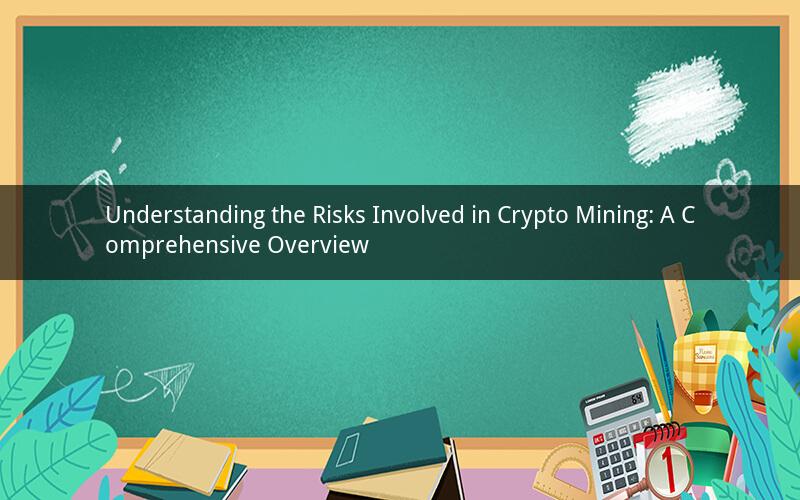
Introduction:
Crypto mining has become an integral part of the cryptocurrency ecosystem, with enthusiasts and investors alike engaging in this lucrative endeavor. However, along with the potential rewards, there are several risks associated with crypto mining that need to be carefully considered. In this article, we will delve into the various risks involved in crypto mining and provide insights into mitigating them.
1. High Energy Consumption:
One of the most significant risks of crypto mining is the substantial energy consumption. Mining cryptocurrencies requires powerful computers that consume a considerable amount of electricity. This has raised concerns about the environmental impact and sustainability of crypto mining operations. To mitigate this risk, miners can opt for renewable energy sources or consider energy-efficient mining hardware.
2. High Initial Investment:
Another major risk is the high initial investment required for setting up a mining rig. The cost of purchasing the necessary hardware, such as graphics cards, motherboards, and cooling systems, can be substantial. Additionally, miners need to factor in the cost of electricity, cooling, and maintenance. To minimize this risk, individuals can consider joining a mining pool or leasing mining equipment instead of purchasing it outright.
3. Volatility of Cryptocurrency Prices:
The price volatility of cryptocurrencies is a significant risk factor for miners. Since the value of cryptocurrencies can fluctuate drastically, miners may experience significant gains or losses depending on the market conditions. It is crucial for miners to conduct thorough market research and have a well-defined risk management strategy to navigate this volatility effectively.
4. Technological Risk:
The crypto mining industry is highly competitive, with new technologies and algorithms emerging regularly. Miners who fail to keep up with technological advancements may face a decline in their mining efficiency and profitability. To mitigate this risk, miners should stay informed about the latest developments in the industry and be willing to invest in new hardware or software when necessary.
5. Legal and Regulatory Risks:
Crypto mining operations can be subject to legal and regulatory challenges, depending on the jurisdiction. Some countries have imposed restrictions or outright bans on crypto mining activities, while others may have specific regulations in place. Miners need to be aware of the legal landscape in their respective regions and ensure compliance with applicable laws to avoid potential legal repercussions.
6. Security Risks:
Crypto mining involves the use of valuable hardware and sensitive data. Miners need to take appropriate security measures to protect their equipment and data from theft, hacking, and other cyber threats. This includes using secure mining pools, implementing robust cybersecurity protocols, and storing cryptocurrencies in secure wallets.
7. Market Risk:
The overall market conditions, including the demand for cryptocurrencies and the supply of mining equipment, can impact the profitability of crypto mining. Excessive supply of mining equipment or a sudden decrease in cryptocurrency demand can lead to a decline in mining profits. Miners should stay informed about market trends and be prepared to adapt their strategies accordingly.
8. Equipment Failure and Maintenance:
Mining equipment, particularly graphics cards, can be prone to failure due to intense usage and overheating. Regular maintenance and proper cooling systems are essential to ensure the longevity and efficiency of mining equipment. Failure to address equipment failures promptly can lead to significant financial losses.
9. Power Supply Reliability:
Crypto mining operations heavily rely on a stable power supply. Power outages or fluctuations can disrupt mining activities and result in financial losses. Miners should consider using uninterruptible power supply (UPS) systems or backup generators to ensure continuous mining operations.
10. Economic Risk:
The overall economic conditions, including inflation rates and currency fluctuations, can impact the profitability of crypto mining. Miners should consider the economic factors that may influence their mining operations and adjust their strategies accordingly.
In conclusion, while crypto mining offers the potential for significant financial rewards, it is crucial to be aware of the associated risks. By understanding and mitigating these risks, individuals can make informed decisions and increase their chances of success in the crypto mining industry.
Questions and Answers:
1. What are the main environmental concerns associated with crypto mining?
Answer: The main environmental concern is the high energy consumption, which contributes to greenhouse gas emissions and increased carbon footprint.
2. How can miners reduce their energy consumption?
Answer: Miners can reduce their energy consumption by using energy-efficient mining hardware, opting for renewable energy sources, and optimizing their mining operations.
3. What are the potential legal and regulatory risks for crypto miners?
Answer: The potential legal and regulatory risks include restrictions or bans on crypto mining activities, tax implications, and compliance with specific regulations in different jurisdictions.
4. How can miners protect their equipment and data from security threats?
Answer: Miners can protect their equipment and data by using secure mining pools, implementing robust cybersecurity protocols, and storing cryptocurrencies in secure wallets.
5. How can miners navigate the volatility of cryptocurrency prices?
Answer: Miners can navigate the volatility by conducting thorough market research, implementing risk management strategies, and staying informed about market trends.